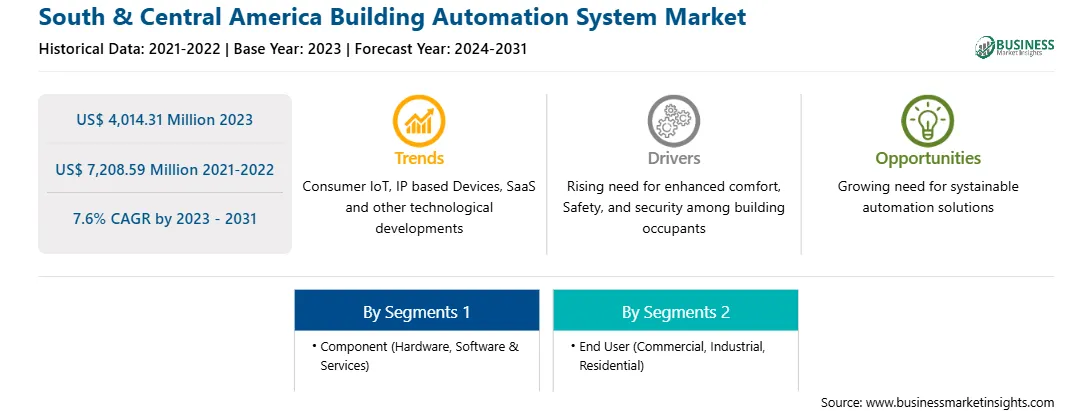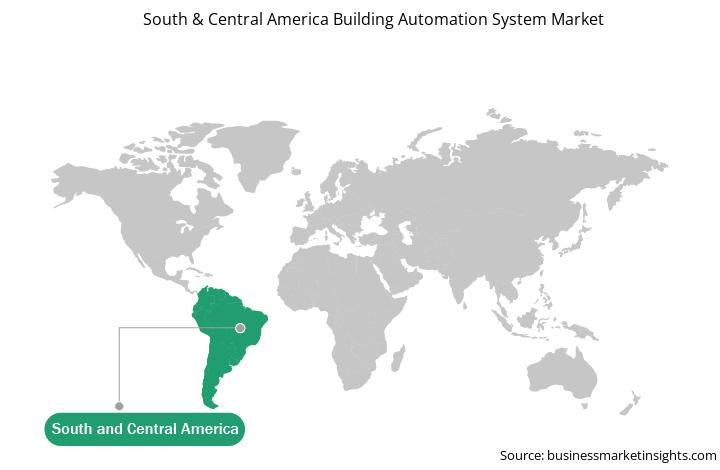South & Central America Building Automation System Market
No. of Pages: 133 | Report Code: BMIRE00031117 | Category: Electronics and Semiconductor
No. of Pages: 133 | Report Code: BMIRE00031117 | Category: Electronics and Semiconductor
The South & Central America building automation system market was valued at US$ 4,014.31 million in 2023 and is expected to reach US$ 7,208.59 million by 2031; it is estimated to register a CAGR of 7.6% from 2023 to 2031.
Sustainable buildings aim to minimize energy consumption and carbon emissions. BAS can monitor, control, and optimize HVAC, lighting, and other systems based on occupancy and environmental conditions. With an increasing shift toward renewable energy sources, such as solar and wind, BAS can intelligently manage the integration and utilization of these sources within building operations, ensuring optimal energy use and substantial cost savings. BAS provides real-time data on energy usage and environmental metrics, facilitating informed decision-making for energy conservation strategies and compliance with sustainability standards and regulations. Sustainable buildings prioritize occupant comfort and health. BAS can maintain indoor air quality, regulate temperature, and optimize natural lighting, contributing to enhanced occupant satisfaction and productivity. Also, sustainable BAS solutions result in cost savings due to reduced energy expenses, lower maintenance needs, and prolonged equipment life, making them financially attractive for building owners and operators. The use of sustainable solutions aligns with global sustainability goals, improving energy efficiency, enhancing occupant comfort, and offering significant economic benefits for building owners and operators. Thus, the growing need for sustainable building automation solutions across industries is expected to create significant opportunities for the building automation market growth during the forecast period.
The building automation market is growing in the SAM. Building automation systems (BAS) solutions for South American structures are crafted to address precise building requirements, offering intuitive interfaces and smooth system integration to facilitate effective communication and information exchange. These systems can manage heating, cooling, lighting, and appliances in commercial towers, resulting in notable energy efficiency improvements and emissions reduction. The building automation systems market in South America is experiencing substantial growth due to the increasing need for efficient automated solutions to automate repetitive tasks, streamline company operations, and prioritize zero-waste production and quicker time-to-market strategies. The market in the region is set for notable expansion, propelled by factors such as a heightened focus on energy preservation, government-initiated programs, and the sustained requirement for efficient automated systems across the region.
Strategic insights for the South & Central America Building Automation System provides data-driven analysis of the industry landscape, including current trends, key players, and regional nuances. These insights offer actionable recommendations, enabling readers to differentiate themselves from competitors by identifying untapped segments or developing unique value propositions. Leveraging data analytics, these insights help industry players anticipate the market shifts, whether investors, manufacturers, or other stakeholders. A future-oriented perspective is essential, helping stakeholders anticipate market shifts and position themselves for long-term success in this dynamic region. Ultimately, effective strategic insights empower readers to make informed decisions that drive profitability and achieve their business objectives within the market. The geographic scope of the South & Central America Building Automation System refers to the specific areas in which a business operates and competes. Understanding local distinctions, such as diverse consumer preferences (e.g., demand for specific plug types or battery backup durations), varying economic conditions, and regulatory environments, is crucial for tailoring strategies to specific markets. Businesses can expand their reach by identifying underserved areas or adapting their offerings to meet local demands. A clear market focus allows for more effective resource allocation, targeted marketing campaigns, and better positioning against local competitors, ultimately driving growth in those targeted areas.South & Central America Building Automation System Strategic Insights

South & Central America Building Automation System Report Scope
Report Attribute
Details
Market size in 2023
US$ 4,014.31 Million
Market Size by 2031
US$ 7,208.59 Million
Global CAGR (2023 - 2031)
7.6%
Historical Data
2021-2022
Forecast period
2024-2031
Segments Covered
By Component
By End User
Regions and Countries Covered
South and Central America
Market leaders and key company profiles
South & Central America Building Automation System Regional Insights

The South & Central America building automation system market is categorized into component, end user, and country.
Based on component, the South & Central America building automation system market is bifurcated into hardware and software & services. The hardware segment held a larger market share in 2023. Furthermore, the hardware segment is sub segmented into security & surveillance system, facility management systems, fire protection systems, and others.
In terms of end user, the South & Central America building automation system market is segmented into commercial, industrial, and residential. The commercial segment held the largest market share in 2023.
By country, the South & Central America building automation system market is segmented into Brazil, Argentina, and the Rest of South & Central America. Brazil dominated the South & Central America building automation system market share in 2023.
ABB Ltd; Mitsubishi Electric Corp; Bosch Sicherheitssysteme GmbH; Honeywell international Inc; Schneider Electric SE; Siemens AG; Johnson Controls International Plc; Carrier Global Corp; Lutron Electronics Co., Inc; and Trane Technologies Plc are some of the leading companies operating in the South & Central America building automation system market.
The South & Central America Building Automation System Market is valued at US$ 4,014.31 Million in 2023, it is projected to reach US$ 7,208.59 Million by 2031.
As per our report South & Central America Building Automation System Market, the market size is valued at US$ 4,014.31 Million in 2023, projecting it to reach US$ 7,208.59 Million by 2031. This translates to a CAGR of approximately 7.6% during the forecast period.
The South & Central America Building Automation System Market report typically cover these key segments-
The historic period, base year, and forecast period can vary slightly depending on the specific market research report. However, for the South & Central America Building Automation System Market report:
The South & Central America Building Automation System Market is populated by several key players, each contributing to its growth and innovation. Some of the major players include:
The South & Central America Building Automation System Market report is valuable for diverse stakeholders, including:
Essentially, anyone involved in or considering involvement in the South & Central America Building Automation System Market value chain can benefit from the information contained in a comprehensive market report.